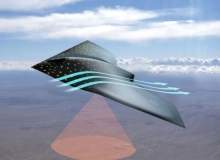

Researchers at BAE System’s Advanced Technology Centre are currently investigating the advanced concept, which embeds tens of thousands of micro-sensors directly into the aircraft skin. The smart skin will allow the aircraft to ‘feel’ wind speed and temperature as well as physical strain on the aircraft.
According to the company, the technology allows aircraft to monitor their health and report back any potential problems before they become significant. As a result, it would reduce the need for regular check-ups on the ground and parts could be replaced in a timely manner which would improve safety overall.
The tiny sensors are called ‘motes’ and can be as small as grains of rice or even dust particles at less than a millimetre across. The sensors have their own power source and would be paired with software that allows them to communicate among themselves, similar to how human skin sends signals to the brain.
BAE Systems says it is exploring several methods to apply the skin including spraying them on like paint. This method would allow the sensors to be applied to existing aircraft without significant modifications.
A spokesman told airforce-technology that it could be another ten years before we see the technology on aircraft like the company’s secret stealth drone Taranis. "It is still very much in the research phase," said the Advanced Technology Centre representative.
How well do you really know your competitors?
Access the most comprehensive Company Profiles on the market, powered by GlobalData. Save hours of research. Gain competitive edge.

Thank you!
Your download email will arrive shortly
Not ready to buy yet? Download a free sample
We are confident about the unique quality of our Company Profiles. However, we want you to make the most beneficial decision for your business, so we offer a free sample that you can download by submitting the below form
By GlobalDataEngineers take inspiration from household appliances
Three new programmes are demonstrating just how far remote controlled legacy aircraft are.
The idea for the smart skin concept came when lead researcher, Lydia Hyde, was using her tumble dryer at home and noticed it used a sensor which prevented it from overheating.
"Observing how a simple sensor can be used to stop a domestic appliance overheating, got me thinking about how this could be applied to my work and how we could replace bulky, expensive sensors with cheap, miniature, multi-functional ones," said Hyde, who is a senior research scientist at the Advanced Technology Centre.
She added: "This in turn led to the idea that aircraft, or indeed cars and ships, could be covered by thousands of these motes creating a ‘smart skin’ that can sense the world around them and monitor their condition by detecting stress, heat or damage. The idea is to make platforms ‘feel’ using a skin of sensors in the same way humans or animals do."
The smart skin concept is part of a range of new technologies being investigated by the British defence giant. Earlier this year, BAE Systems revealed a number of future concepts it was working on including an aircraft which can split into smaller aircraft, an aircraft which makes drones using 3D printers and a self-healing fighter jet. The new skin concept could work in conjunction with these advanced technologies, with a future aircraft being able to sense damage and then fix itself mid-flight.
Follow Grant Turnbull on Google+


.gif)





